SaaS Annual Report 2023-2024: Trends and Insights
Notes on SaaS Annual Report 2023-2024 Overview
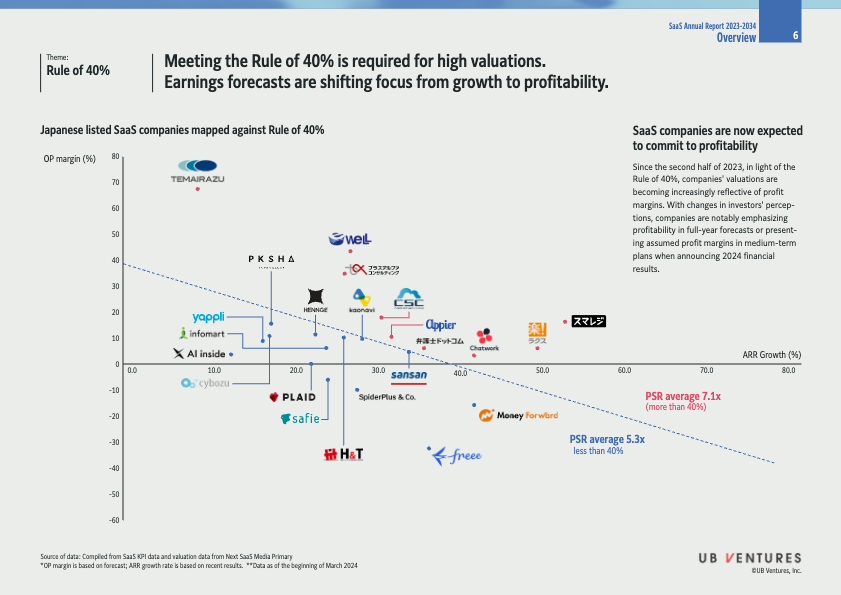
Theme: Rule of 40%
- The Rule of 40% is a benchmark for SaaS (Software as a Service) companies that combines revenue growth and profit margin.
- A company is considered healthy if the sum of its annual revenue growth rate and profit margin is at least 40%. This rule serves as a guideline for evaluating the efficiency of SaaS businesses.
Key Insights
- As of the second half of 2023, there is a greater emphasis on profitability in valuations of SaaS companies. Investors are increasingly favoring companies that demonstrate not just growth but sustainable profitability.
Earnings Focus
- Earnings forecasts are notably shifting from mere growth metrics to a focus on profit margins. This indicates a change in investor sentiment favoring profitability over rapid expansion.
- Companies are expected to:
- Commit to profitability in their financial outlook.
- Present assumed profit margins in longer-term financial plans (e.g., for 2024).
Japanese Listed SaaS Companies
Chart Overview
- The chart presents Japanese listed SaaS companies plotted against the Rule of 40%, displaying both Operating Margin (%) and Annual Recurring Revenue (ARR) Growth (%) .
Data Summary
- Operating Margin (OP Margin) % vs ARR Growth % :
| OP Margin (%) | ARR Growth (%) |
|---|---|
| -60 | 0 |
| -50 | 10 |
| -40 | 20 |
| -30 | 30 |
| -20 | 40 |
| -10 | 50 |
| 0 | 60 |
| 10 | 70 |
| 20 | 80 |
PSR (Price-to-Sales Ratio) Averages
- Companies with an average PSR of 7.1x exhibit growth and profits more than 40% , indicating strong valuations.
- Companies with an average PSR of 5.3x have profits less than 40% , reflecting comparatively weaker valuations.
Conclusion
- Meeting the Rule of 40% is becoming essential for SaaS companies seeking high valuations as the focus shifts to profitability. This aligns with trends seen in investor perspectives and market expectations.
Extended readings:
SaaS Annual Report 2023-2034: ARR Acquisition Efficiency
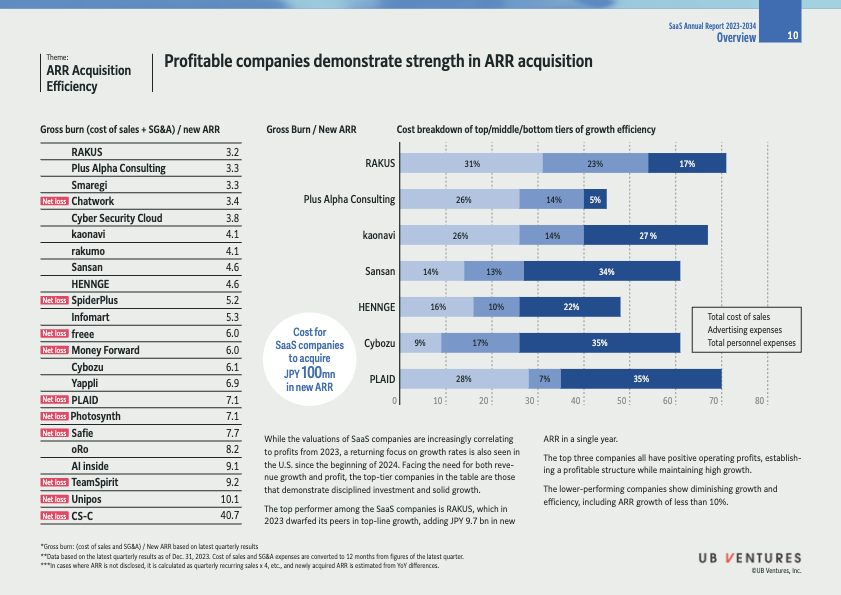
Overview of ARR Acquisition Efficiency
- The report highlights the correlation between profitability and ARR (Annual Recurring Revenue) acquisition among SaaS (Software as a Service) companies.
- A notable trend is observed where investor focus is shifting towards companies demonstrating growth alongside profitability.
Key Metrics
Gross Burn Calculation
- Gross burn is defined as the formula:
Gross Burn = (Cost of Sales + SG&A) / New ARR
This highlights the efficiency of a company in acquiring new ARR relative to its costs.
Performance Overview of Companies
Here are the figures based on the gross burn per different companies, showcasing the net losses and efficiency in acquiring new ARR:
| Company | Gross Burn (Cost of Sales + SG&A) / New ARR | Net Loss |
|---|---|---|
| RAKUS | 3.2 | - |
| Plus Alpha Consulting | 3.3 | - |
| Smaregi | 3.3 | - |
| Chatwork | 3.4 | - |
| Cyber Security Cloud | 3.8 | - |
| kaonavi | 4.1 | - |
| rakumo | 4.1 | - |
| Sansan | 4.6 | - |
| HENNGE | 4.6 | - |
| SpiderPlus | 5.2 | - |
| Infomart | 5.3 | - |
| freee | 6.0 | - |
| Money Forward | 6.0 | - |
| Cybozu | 6.1 | - |
| Yappli | 6.9 | - |
| PLAID | 7.1 | - |
| Photosynth | 7.1 | - |
| Safie | 7.7 | - |
| oRo | 8.2 | - |
| AI inside | 9.1 | - |
| TeamSpirit | 9.2 | - |
| Unipos | 10.1 | - |
| CS-C | 40.7 | - |
Cost Breakdown of Growth Efficiency Tiers
The cost efficiency breakdown reveals different tiers of growth among selected companies based on their ability to manage expenses in relation to new ARR:
| Company | Cost Breakdown (Top/Middle/Bottom Tiers) |
|---|---|
| RAKUS | 31% / 23% / 17% |
| Plus Alpha Consulting | 26% / 14% / 5% |
| kaonavi | 26% / 14% / 27% |
| Sansan | 14% / 13% / 34% |
| HENNGE | 16% / 10% / 22% |
| Cybozu | 9% / 17% / 35% |
| PLAID | 28% / 7% / 35% |
Insights and Trends
- Profitability and Growth Correlation: The top three companies (RAKUS, Plus Alpha Consulting, and kaonavi) exhibit positive operating profits while maintaining high growth. Thus, they serve as benchmarks for efficient ARR acquisition.
- Lower Performance Indicators: Some companies are showing diminishing growth with ARR growth rates below 10%, indicating a potential concern for sustainability in growth.
- Investment Discipline: Successful companies are those that balance disciplined investment with solid growth strategies.
Conclusion
This report underscores the significance of acquiring new ARR efficiently while navigating operational costs. Companies that can strike a balance between profitability and growth are more likely to attract investors in the evolving SaaS landscape.
Extended readings:
Vertical SaaS Growth Potential in Regional Economies
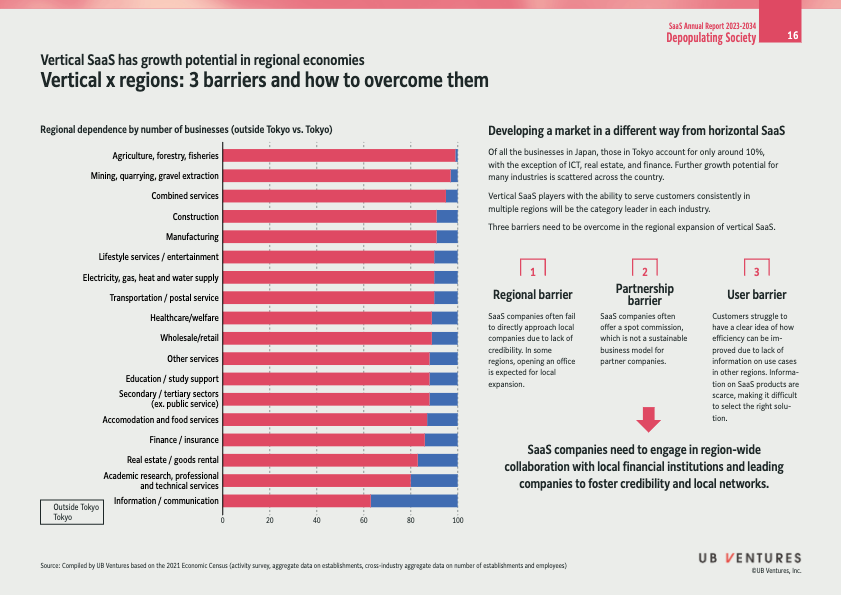
Overview
Vertical SaaS (Software as a Service) holds significant potential for growth in regional economies outside of Tokyo, Japan. This potential stems from the diverse industry presence in these regions, as opposed to the heavy concentration of businesses in Tokyo, which accounts for only about 10% of all businesses in Japan. Key industries such as ICT, real estate, and finance show varying degrees of growth potential scattered across the country.
Barrier Analysis
Three main barriers have been identified that may hinder the regional expansion of vertical SaaS:
-
Regional Barrier
- SaaS companies often struggle to directly engage with local businesses due to a perceived lack of credibility.
- Insight: Building local partnerships and establishing a physical presence, such as regional offices, may enhance trust and facilitate entry into these markets.
-
Partnership Barrier
- Some SaaS companies provide only a spot commission, which is not a sustainable business model for their partner companies.
- Insight: Developing long-term partnerships and creating incentive structures that benefit both SaaS companies and local partners can strengthen business relationships.
-
User Barrier
- Customers often lack clarity on how SaaS solutions can improve their efficiency due to insufficient information on successful use cases in other regions.
- Insight: More robust educational resources and case studies should be created and shared to demonstrate the value of SaaS products.
Industry Dependence by Number of Businesses
The following table presents regional dependence by the number of businesses in various sectors, comparing data from outside Tokyo to those located within it:
| Industry Name | Outside Tokyo | Tokyo |
|---|---|---|
| Agriculture, Forestry, Fisheries | ||
| Mining, Quarrying, Gravel Extraction | ||
| Combined Services | ||
| Construction | ||
| Manufacturing | ||
| Lifestyle Services / Entertainment | ||
| Electricity, Gas, Heat and Water Supply | ||
| Transportation / Postal Service | ||
| Healthcare / Welfare | ||
| Wholesale / Retail | ||
| Other Services | ||
| Education / Study Support | ||
| Secondary / Tertiary Sectors (ex. Public Service) | ||
| Accomodation and Food Services | ||
| Finance / Insurance | ||
| Real Estate / Goods Rental | ||
| Academic Research, Professional and Technical Services | ||
| Information / Communication |
The specific numerical values in the table are not provided in the image. The insights drawn are based on the context of regional economic activities and barriers faced.
Conclusion
SaaS companies need to foster credibility and build local networks through collaboration with local financial institutions and regional companies. Effective engagement strategies will be essential to navigate barriers and unlock the vast potential for vertical SaaS in Japan’s regional economies.
Extended readings:
SaaS IPO Annual Report 2023-2024 Overview
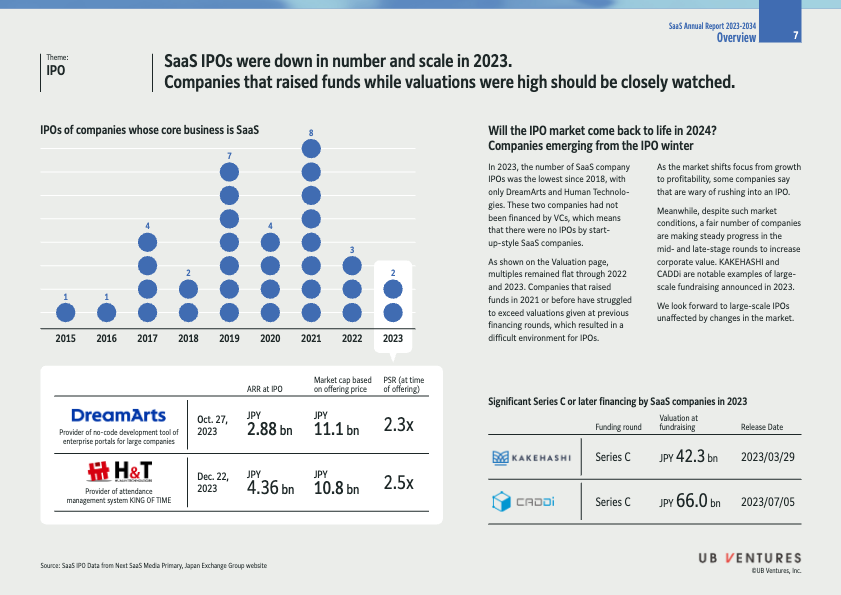
Key Insights
- SaaS IPO Activity: The number of SaaS company IPOs in 2023 was the lowest since 2018, with only two companies (DreamArts and Human Technologies) going public.
- Funding Sources: These two companies did not receive funding from Venture Capitalists (VCs), indicating a lack of fresh capital typically associated with startup-style SaaS companies.
- Market Trend: There's a noted shift in the market focus from growth to profitability, causing companies to be cautious about rushing into IPOs.
- Future Outlook: Despite challenging conditions, some companies are successfully navigating mid- and late-stage funding rounds, indicating potential for recovery in the IPO market in 2024.
IPO Overview
IPO Numbers by Year
| Year | Number of IPOs |
|---|---|
| 2015 | 1 |
| 2016 | 1 |
| 2017 | 4 |
| 2018 | 2 |
| 2019 | 7 |
| 2020 | 4 |
| 2021 | 8 |
| 2022 | 3 |
| 2023 | 2 |
- Insight: The significant increase in IPOs from 2018 to 2021 (with a peak in 2021) demonstrates increased market confidence and investment in SaaS. The decline in 2022 and 2023 indicates a cooling off and possible market correction.
Valuation Context
- Valuation Trends: Multiples remained flat from 2022 to 2023. Companies that raised funds in 2021 or earlier are struggling to surpass their previous valuations.
Notable SaaS Companies and Fundraising in 2023
| Company | Funding Round | ARR at IPO | Market Cap (at offering) | PSR (Price-to-Sales Ratio) | Release Date |
|---|---|---|---|---|---|
| DreamArts | Series C | JPY 2.88 bn | JPY 11.1 bn | 2.3x | Oct. 27, 2023 |
| H&T | Series C | JPY 4.36 bn | JPY 10.8 bn | 2.5x | Dec. 22, 2023 |
- Additional Insight: The PSR values indicate that these companies are valued in relation to their sales, providing insight into market expectations for their future revenue growth.
Future Considerations
- Market Recovery: Companies like KAKEHASHI and CADDi are showing positive trends in large-scale fundraising in 2023, suggesting that while the IPO market is currently subdued, there may be opportunities for resurgence as the market stabilizes.
- Strategic Caution: The shift in focus within the market highlights the importance for SaaS companies to demonstrate profitability to attract investment and successfully navigate IPO processes.
Conclusion
The report underscores a critical juncture for SaaS IPOs as they navigate through a challenging economic landscape. Attention to valuation and strategic fundraising will be key for successful entries into more favorable market conditions in the future.
Extended readings:
日本のSaaSスタートアップにおける資金調達の概要
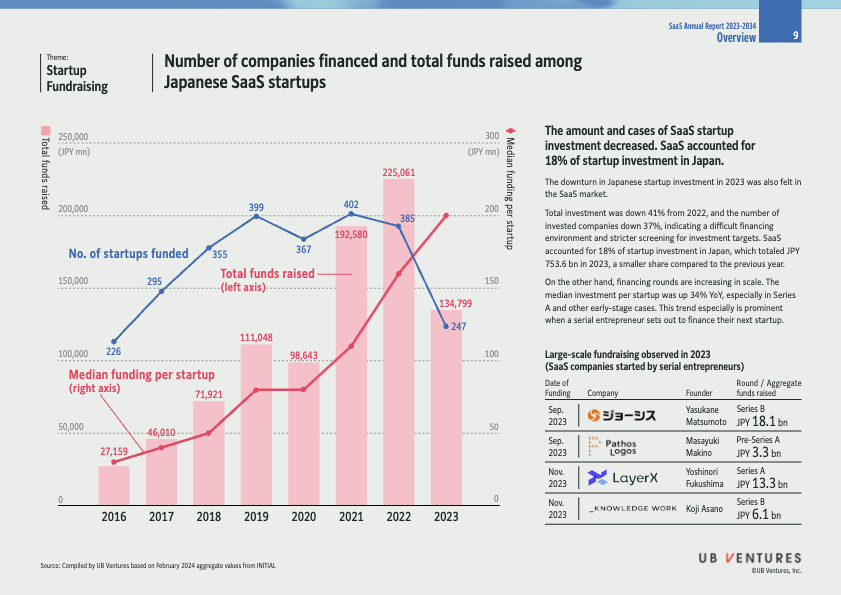
概要
- 2023年のSaaSスタートアップへの投資額と件数は減少。
- SaaSは日本のスタートアップ投資の18%を占める。
- 日本のスタートアップ投資総額は753.6億JPYで、前年と比べて減少。
データ概要
| 年 | 資金を調達したスタートアップ数 | 総資金調達額 (JPY mn) | スタートアップあたりの中央値資金 (JPY) |
|---|---|---|---|
| 2016年 | 226 | 27,159 | 71,921 |
| 2017年 | 295 | 46,010 | - |
| 2018年 | 355 | 111,048 | - |
| 2019年 | 367 | 98,643 | - |
| 2020年 | 402 | 192,580 | - |
| 2021年 | 399 | 225,061 | - |
| 2022年 | 385 | 134,799 | - |
| 2023年 | 247 | - | - |
データポイントの洞察
- 資金調達したスタートアップ数: 2023年は247社に移行し、前年から37%減少。これは、投資環境の厳格化を示す。
- 総資金調達額: 134,799百万JPYと推測されるが、詳細は2023年の最終数値を待つ必要がある。
- スタートアップあたりの中央値資金: 71,921JPYが2022年の中央値となっており、資金分配の傾向を浮き彫りにしている。
2023年の大規模資金調達事例(連続起業家によるSaaS企業)
| 日付 | 会社名 | 創業者 | ラウンド | 総資金調達額 (JPY bn) |
|---|---|---|---|---|
| 2023年9月 | ショウサン | 安川正人 | シリーズB | 18.1 |
| 2023年9月 | Pathos Logos | 増本雅之 | プレシリーズA | 3.3 |
| 2023年11月 | LayerX | 福島義則 | シリーズA | 13.3 |
| 2023年11月 | -KNOwLEDGE Work- | 浅野浩二 | シリーズB | 6.1 |
事例の洞察
- 2023年には、特に早期段階のファイナンスラウンドでの投資が増加している。
- シリーズAでは中央値の投資が34%増加し、起業家の循環が影響を及ぼしている。
総括
- 日本のSaaS市場は投資環境の変化に直面しているが、資金調達の規模は増加傾向にある。
- 将来の資金調達環境やスタートアップの健全性に関する注視が必要。
Extended readings:
Issues and Solutions in the Construction Industry
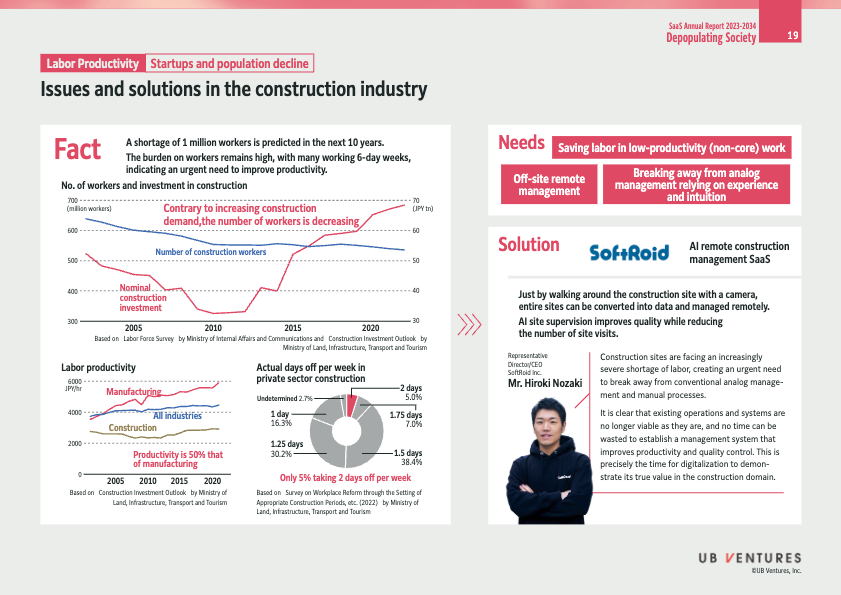
Key Facts
- Labor Shortage: A predicted shortage of 1 million workers in the next 10 years, highlighting the urgent need for improved productivity.
- Worker Burden: High pressure on workers, many working 6-day weeks.
Labor Productivity Insights
- Construction Productivity: Only 50% of the productivity level in manufacturing.
- Low Days Off: Only 5% of workers take 2 days off per week, indicating an overworked labor force.
Actual Days Off Per Week in Private Sector Construction
| Days Off | Percentage (%) |
|---|---|
| 2 days | 5.0 |
| 1 day | 16.3 |
| 1.75 days | 7.0 |
| 1.5 days | 38.4 |
| 1.25 days | 30.2 |
| Undetermined | 2.7 |
Construction Workforce Trends
Number of Workers and Investment Trends (in million workers)
| Year | Number of Construction Workers (million) | Nominal Construction Investment (JPY tn) |
|---|---|---|
| 2005 | 600 | 30 |
| 2010 | 500 | 40 |
| 2015 | 400 | 50 |
| 2020 | 300 | 60 |
Observations
- Decreasing Workforce: Contrary to the increasing demand for construction, the number of workers is decreasing.
- Investment Trends: The nominal investment in construction has generally increased over the years, despite the declining number of workers.
Needs Identified
- Saving Labor in Low-Productivity Work: Focusing on reducing labor in non-core activities to maximize productivity.
- Off-site Remote Management: Emphasizing the need for managing construction sites remotely to improve efficiency.
- Breaking Away from Analog Management: Transitioning from traditional methods reliant on experience and intuition is crucial for modernizing construction management.
Proposed Solution: AI Remote Construction Management SaaS
- Introduction to SoftRoid: A solution that enables data conversion of entire construction sites via camera technology.
- Improved Site Supervision: Enhances project quality while reducing the necessity for site visits.
Representative Insight
Mr. Hiroki Nozaki, Director/CEO of SoftRoid, emphasizes the urgency for construction sites to overcome severe labor shortages by adopting digital management systems that enhance productivity and quality control.
Conclusion
This analysis outlines the pressing challenges faced by the construction industry, primarily driven by labor shortages and productivity inefficiencies. The transition to AI-driven management solutions is pivotal for addressing these issues effectively.
UB Ventures Overview
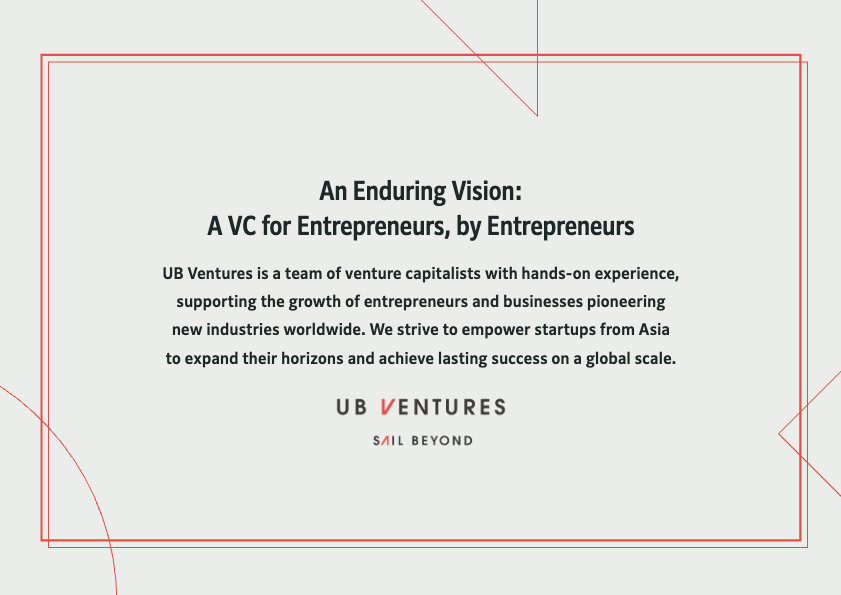
Vision Statement
- An Enduring Vision: A VC for Entrepreneurs, by Entrepreneurs.
- This highlights the mission of UB Ventures to create a supportive environment for entrepreneurs.
About UB Ventures
-
Team Composition:
- Comprised of venture capitalists with hands-on experience.
- This suggests that the team not only invests but also has practical knowledge in running businesses.
-
Mission:
- Supporting the growth of entrepreneurs and businesses that are creating new industries worldwide.
- This indicates a focus on innovation and leadership in emerging sectors.
-
Empowerment Focus:
- Striving to empower startups from Asia.
- Encourages expansion beyond local markets, aiming for global presence and success.
Key Insights
-
Venture Capitalists (VCs):
- Professionals who invest in startups and early-stage companies in exchange for equity.
- Hands-on experience implies that the team can provide more than just funding, including mentorship and strategic guidance.
-
Global Market Approach:
- The focus on "lasting success on a global scale" signifies a strategic outlook towards international market integration.
- Asian startups may have unique advantages such as access to large markets, but need support to navigate global challenges.
Conclusion
UB Ventures emphasizes a collaborative approach to venture capital, aiming to foster growth and success for entrepreneurs via experience and mentorship on a global platform.
Extended readings:
SaaS Annual Report 2023-2024 Overview
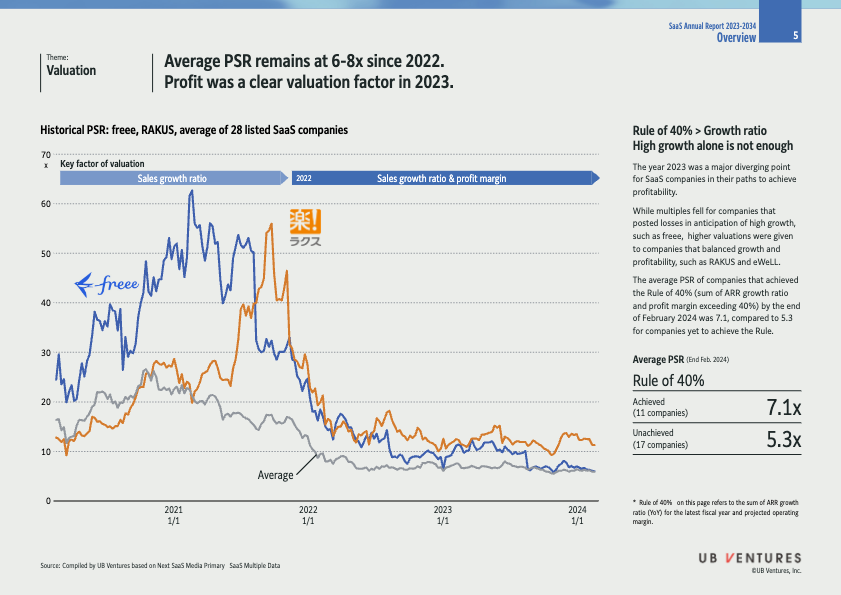
Key Insights
-
Valuation Trends (2022-2024)
- Average Price to Sales Ratio (PSR) has consistently remained between 6x to 8x since 2022.
- Profitability emerged as a significant factor for valuations in 2023, affecting how companies are perceived in the market.
-
Rule of 40%
- The Rule of 40% indicates that the sum of Annual Recurring Revenue (ARR) growth ratio and profit margin should exceed 40% for SaaS companies to be deemed financially healthy.
- SaaS companies achieving this metric demonstrated higher valuations. Companies achieving the Rule had an average PSR of 7.1x, while those that did not achieved an average PSR of 5.3x.
Historical PSR Data (Average of 28 Listed SaaS Companies)
| Year | 2021 | 2022 | 2023 | 2024 (End Feb) |
|---|---|---|---|---|
| PSR (x) | ||||
| Average | 10 | 20 | 30 | |
| freee | 40 | 50 | ||
| RAKUS |
Observations:
- Key Factor of Valuation: Sales growth ratio shows fluctuations, with notable increases in specific years.
- Companies like freee showed significant growth ratios, which impacted their PSR values.
Implications for SaaS Companies
- Growth vs. Profitability: Companies are increasingly being evaluated not just on growth potential but also on their ability to generate profits.
- Strategic Focus: SaaS companies should aim to balance growth initiatives with profitability measures to enhance their market valuations.
Sources
- Compiled by UB Ventures based on Next SaaS Media Primary and SaaS Multiple Data.
Extended readings:
Vertical SaaS Investment and the “2024 Problem”
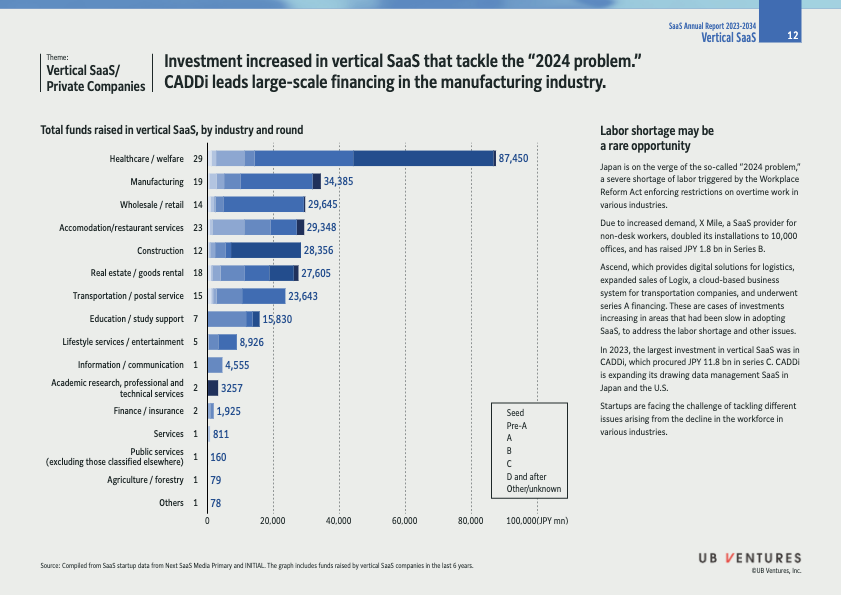
Key Insights
- Investment Trends: There is a notable increase in investments in vertical SaaS addressing the impending “2024 problem” in Japan, characterized by a severe labor shortage due to new regulations on overtime work.
- Leading Companies: CADDi has emerged as a significant player in this space, raising large-scale financing for data management SaaS aimed at manufacturing and other sectors.
Total Funds Raised in Vertical SaaS by Industry
| Industry | Number of Companies | Total Funds Raised (JPY mn) |
|---|---|---|
| Healthcare / welfare | 29 | 87,450 |
| Manufacturing | 19 | 34,385 |
| Wholesale / retail | 14 | 29,645 |
| Accommodation / restaurant services | 23 | 29,348 |
| Construction | 12 | 28,356 |
| Real estate / goods rental | 18 | 27,605 |
| Transportation / postal service | 15 | 23,643 |
| Education / study support | 7 | 15,830 |
| Lifestyle services / entertainment | 5 | 8,926 |
| Information / communication | 1 | 4,555 |
| Academic research, professional and technical services | 2 | 3,257 |
| Finance / insurance | 2 | 1,925 |
| Services | 1 | 811 |
| Public services (excluding others) | 1 | 160 |
| Agriculture / forestry | 1 | 79 |
| Others | 1 | 78 |
Insights on Fund Distribution
- Healthcare and Welfare: The largest investment area with a staggering JPY 87.45 billion, likely reflecting the need for innovative solutions amid demographic changes.
- Manufacturing Sector: Second highest at JPY 34.39 billion, highlighting the growth potential in business processes as companies look to improve efficiency.
Addressing the Labor Shortage
- 2024 Problem: The term refers to the labor shortage anticipated due to reforms in labor laws in Japan, impacting various industries significantly.
- SaaS Providers Rising to the Challenge:
- X Mile: A SaaS for non-desk workers, has increased installations to 10,000 offices and raised JPY 1.8 billion in Series B funding.
- Ascend: Focused on logistics, expanded its cloud-based system, Logix, and successfully underwent Series A financing.
Future Outlook
- Companies like CADDi are set to expand into U.S. markets, indicating a global interest in resolving labor inefficiencies through SaaS investments.
- Opportunity for Startups: The ongoing labor shortage presents startups with unique challenges and opportunities to innovate within traditional industries by leveraging SaaS technology.
Conclusion
The data reflects both a trend towards increased funding in vertical SaaS and the urgent need for solutions to address Japan's impending labor challenges. This landscape is ripe for innovation as companies seek to enhance efficiency in response to the "2024 problem."
Extended readings:
Product Portfolios of Top Listed SaaS Companies in Japan
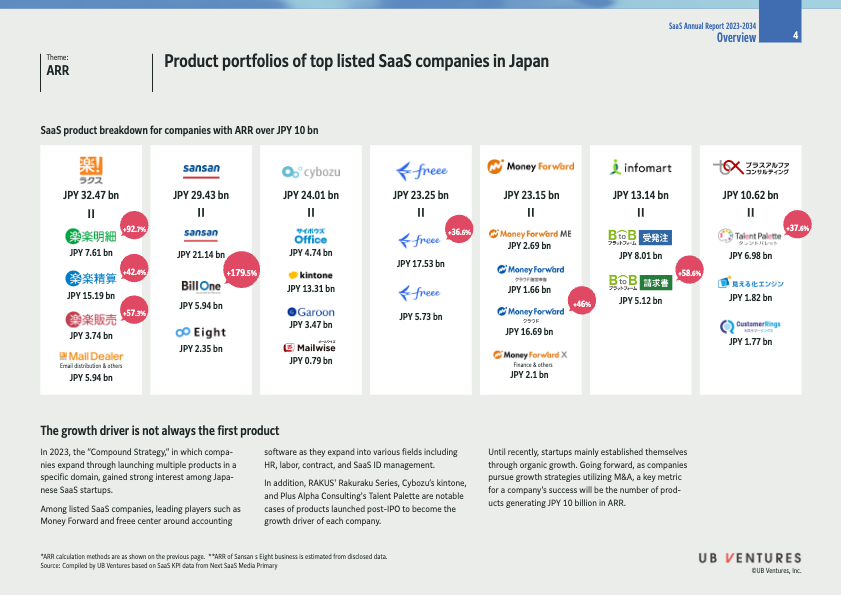
Overview of SaaS Companies with ARR Over JPY 10 bn
Key Companies and Their ARR Breakdown
| Company | ARR (JPY bn) | Notable Products |
|---|---|---|
| Sakura | 32.47 | - |
| Sansan | 29.43 | - Business card management |
| Cybozu | 24.01 | - Office collaboration software |
| freee | 23.25 | - Accounting software |
| Money Forward | 23.15 | - Financial management tools |
| infomart | 13.14 | - Business information service |
| GMO Payment Gateway | 10.62 | - Payment processing services |
Product Insights:
- Growth Drivers: The report highlights that in 2023, a "Compound Strategy" is emerging, where companies expand by launching multiple products rather than focusing on a single product. This approach is attracting strong interest among Japanese SaaS startups.
- Diverse Applications: Companies like Money Forward and freee are diversifying from their core accounting products into fields such as HR management and SaaS ID management, indicating a trend towards comprehensive service offerings.
Additional Insights:
- Post-IPO Product Launches: The expansion into new product areas is often seen in companies after they go public, such as RAKUS’ Rakuraku Series and Cybozu's kintone, which have become key growth drivers for these companies.
- Future Growth Strategies: Historically, startups grew organically, but there is a notable shift towards mergers and acquisitions (M&A) as a means to drive growth. Companies will increasingly be assessed on the number of products they have that generate JPY 10 billion in annual recurring revenue (ARR).
Performance Indicators:
- ARR Calculations: The ARR calculation methods are noted to be consistent with previous analyses, ensuring a reliable measure of company performance.
- Market Dynamics: Companies are now expected to innovate and diversify to meet market demands and maintain competitive advantages, as indicated by growth percentages and strategic shifts observed in the sector.
Conclusion
The landscape of SaaS companies in Japan is evolving, with a strong focus on multi-product strategies and diversification into various business domains. This trend signifies an opportunity for companies to not only sustain but also enhance their market positions by leveraging a range of software solutions.
Extended readings:
2023年における日本のSaaS企業によるM&Aの記録
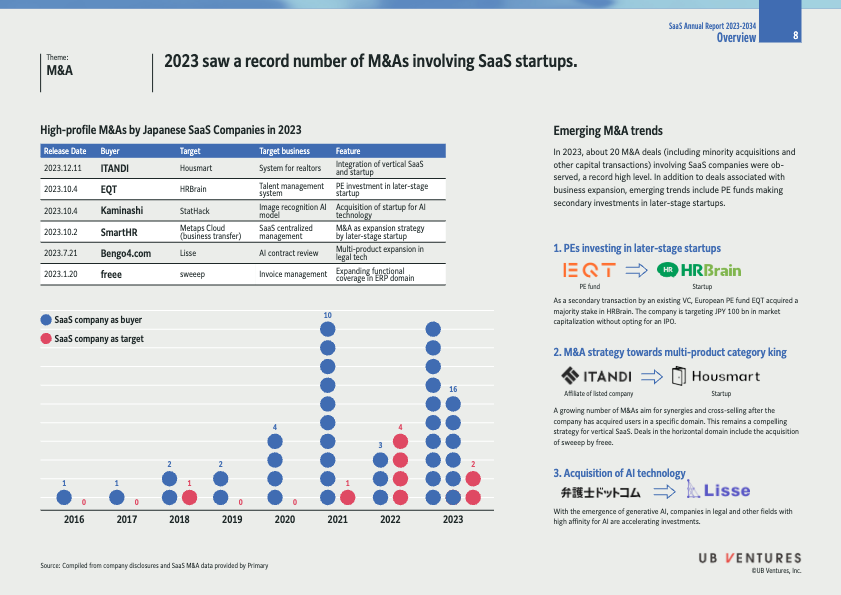
高プロフィールなM&A(2023年)
| Release Date | Buyer | Target | Target Business | Feature |
|---|---|---|---|---|
| 2023.12.11 | ITANDI | Housmart | System for realtors | Integration of vertical SaaS and startup |
| 2023.10.4 | EQT | HRBrain | Talent management system | PE investment in later-stage startup |
| 2023.10.4 | Kaminashi | StatHack | Image recognition AI model | Acquisition of startup for AI technology |
| 2023.10.2 | SmartHR | Metaps Cloud | SaaS centralized management | M&A as expansion strategy by later-stage startup |
| 2023.7.21 | Bengo4.com | Lisse | AI contract review | Multi-product expansion in legal tech |
| 2023.1.20 | freee | sweeep | Invoice management | Expanding functional coverage in ERP domain |
主な洞察
-
SaaS企業のM&A: 2023年には約20件のSaaS企業によるM&A(マイナーな買収を含む)が記録され、これは過去最高の数値である。ビジネス拡大に関連した取引の他に、後期スタートアップに対するPE(プライベート・エクイティ)ファンドからのセカンダリー投資が見られる。
-
市場動向:
- PEファンドの投資: European PE fund EQTがHRBrainの過半数株を取得。この企業は、IPOを選ばずに市場価値をJPY 100億に引き上げることを目指している。
- マルチプロダクト戦略: 特定のドメインでユーザーを獲得した後のシナジーやクロスセリングを狙ったM&Aが増加傾向にある。
- AI技術の取得: ジェネレーティブAIの台頭により、法律関連などAIとの高い親和性を持つ企業が投資を加速している。
データ分析
- M&A動向:
- 2016年から2023年までのSaaS企業による買収およびターゲットの数を示したチャートがある。特に2023年には顕著な増加を見せており、2022年の16件から2023年には2件の購入に対して多くのターゲットが存在している。
結論
2023年は日本のSaaS企業にとって、M&Aが特に活発な年となり、多様な戦略が採用される中、AI技術と各社のコアバリューに基づく連携が重要視されている。
Extended readings:
Can Japan Overcome the World’s Fastest Decline of Its Workforce?
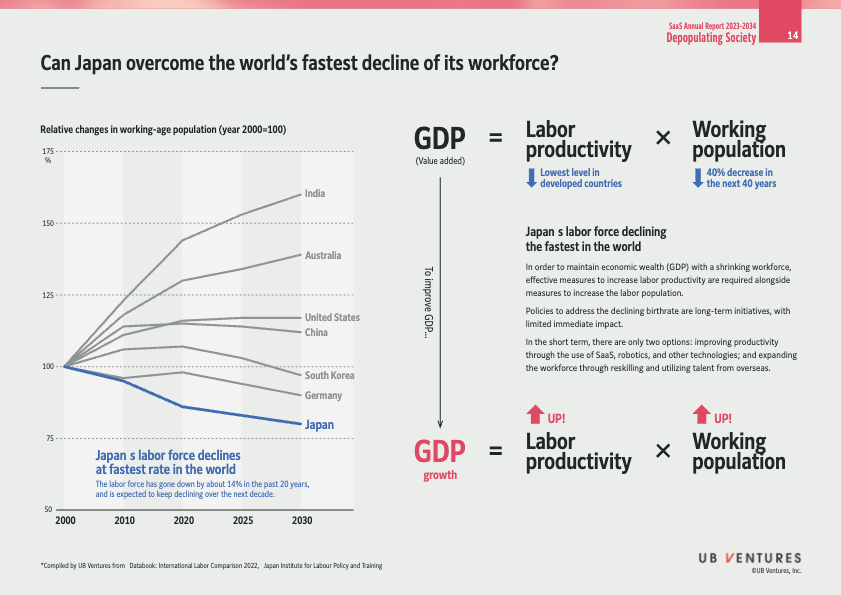
Overview
Japan's labor force is declining at the fastest rate globally, leading to significant concerns about its economic stability and growth. This report outlines the implications of this demographic shift and potential strategies for recovery.
Key Points
Labor Force Decline in Japan
- Current Trends: Japan's labor force has decreased by approximately 14% over the last 20 years. It is projected to continue declining over the next decade.
- Insight: This decline is the result of several factors, including a low birthrate and an aging population, which may challenge economic productivity.
Comparison of Working-Age Population Changes (2000-2030)
| Country | Relative Changes in Working-Age Population (Year 2000=100) |
|---|---|
| India | 175% |
| Australia | 150% |
| United States | 125% |
| China | 125% |
| South Korea | 100% |
| Germany | 100% |
| Japan | 75% |
- Insight: This table demonstrates a stark contrast between Japan and other nations, indicating Japan's significant demographic challenges compared to growth in other economies.
GDP and Labor Implications
- GDP Formula:
- Insight: Japan faces low labor productivity, the lowest level in developed countries, exacerbating the impact of a declining working population.
Strategies for Economic Stability
- Immediate Options:
- Improving Productivity: Utilizing technologies such as SaaS (Software as a Service), robotics, and automation to enhance labor productivity.
- Expanding Workforce: Reskilling the current workforce and recruiting talent from overseas can help mitigate decline.
- Long-Term Policies: Addressing the declining birthrate through family-friendly policies and incentives that promote higher birth rates, although these initiatives tend to have limited immediate effects.
Challenges for Japan
- Projected Decline: A 40% decrease in the working population is expected over the next 40 years.
- Conclusion: Without immediate and effective strategies to boost labor productivity and workforce numbers, Japan's economy may face severe challenges.
Final Thoughts
Japan's demographic decline poses a unique puzzle that requires innovative solutions. Focusing on technology and global talent acquisition may provide pathways to economic sustainability in the face of a shrinking workforce.
Extended readings:
24 Startups Tackling the Challenges of a Depopulating Society
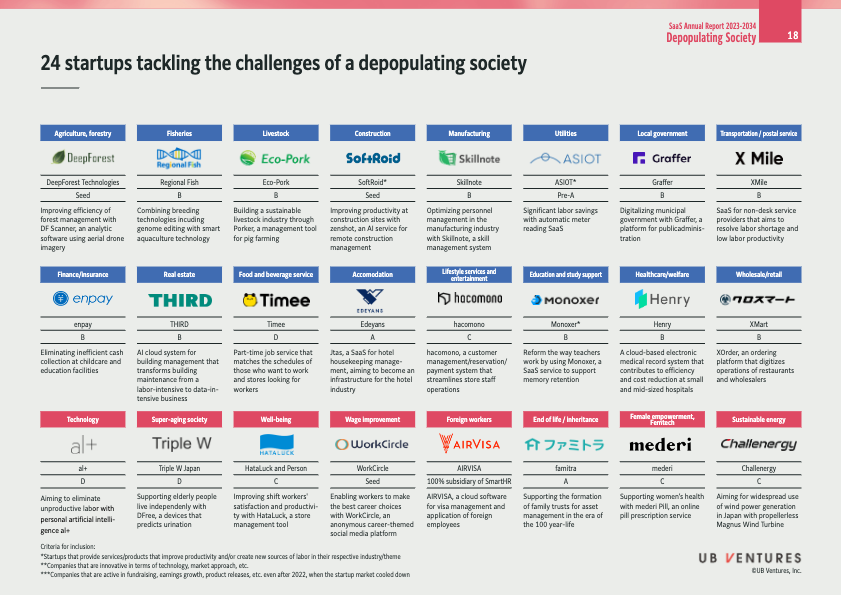
Overview
This note captures insights into startups aimed at addressing societal challenges due to depopulation, as outlined in the SaaS Annual Report 2023-2034. Each startup focuses on distinct sectors contributing to improved efficiency and productivity.
Startup Category Overview
| Sector | Startup Name | Description | Stage |
|---|---|---|---|
| Agriculture, Forestry | DeepForest Technologies | Improving efficiency of forest management with DF Scanner, an analytic software using aerial drone imagery. | Seed |
| Fisheries | Regional Fish | Combining breeding technologies including genome editing with smart aquaculture technology. | B |
| Livestock | Eco-Pork | Building a sustainable livestock industry through Porker, a management tool for pig farming. | B |
| Construction | SoftRoid | Improving productivity at construction sites with Zenshot, an AI service for remote construction management. | Seed |
| Manufacturing | Skillnote | Optimizing personnel management in the manufacturing industry with Skillnote, a skill management system. | B |
| Utilities | ASIOT | Significant labor savings with automatic meter reading SaaS. | Pre-A |
| Local Government | Graffer | Digitalizing municipal government operations with Graffer, a platform for public administration. | B |
| Transportation/Post Services | XMile | SaaS for non-desk service providers that aims to resolve labor shortage and low productivity. | B |
| Finance/Insurance | enpay | Eliminating inefficient cash collection at childcare and education facilities. | B |
| Real Estate | THIRD | AI cloud system for building management that transforms building maintenance from labor-intensive to data-intensive. | B |
| Food and Beverage Service | Timee | Part-time job service matching workers' schedules with stores looking for help. | D |
| Accommodation | Edeyans | SaaS for hotel housekeeping management, aiming to become an infrastructure for the hotel industry. | A |
| Lifestyle Services and Entertainment | hacomono | Customer management/reservation system that streamlines store staff operations. | C |
| Education and Study Support | Monoxer | Reforming teacher workflows through a SaaS service supporting memory retention. | B |
| Healthcare/Welfare | Henry | Cloud-based electronic medical record system for efficiency and cost reduction at small/mid-sized hospitals. | B |
| Wholesale/Retail | XMart | A platform that digitizes the operations of restaurants and wholesalers. | B |
| Technology | al+ | Aiming to eliminate unproductive labor with personal artificial intelligence. | D |
| Super-Aging Society | Triple W | Supporting elderly independence with a device that predicts urination. | D |
| Well-being | HataLuck and Person | Enhancing shift workers' satisfaction and productivity with a store management tool. | C |
| Wage Improvement | WorkCircle | Enabling workers to make the best career choices through an anonymous career-themed social media platform. | Seed |
| Foreign Workers | AIRVISA | Cloud software for visa management for foreign employees; a subsidiary of SmartHR. | 100% |
| End of Life/Inheritances | famitra | Supporting family trust formation for asset management in the 100-year life era. | A |
| Female Empowerment, Femtech | mederi | Supporting women’s health with an online pill prescription service. | C |
| Sustainable Energy | Challenergy | Aiming for widespread use of wind power in Japan with a propellerless Magnus Wind Turbine. | C |
Insights and Key Ideas
- Technology Integration: Many of these startups leverage advanced technology (like AI and cloud computing) to enhance productivity and operational efficiency.
- Focus on Labor Shortages: Multiple companies specifically address labor shortages, reflecting a broader societal issue amidst depopulation trends.
- Diverse Applications: The range of sectors highlighted indicates a comprehensive approach to tackling various aspects of societal challenges related to a decreasing population.
- Sustainability Considerations: Startups like Challenergy point toward a trend in sustainable solutions, emphasizing the need for environmentally friendly innovations.
- Empowerment Initiatives: The presence of Femtech startups underscores the increasing focus on women’s health and empowerment in business strategies.
This structured note provides a clear and comprehensive overview of the startups and their respective roles in addressing depopulation challenges.
Extended readings:
Notes on Tackling Population Decline
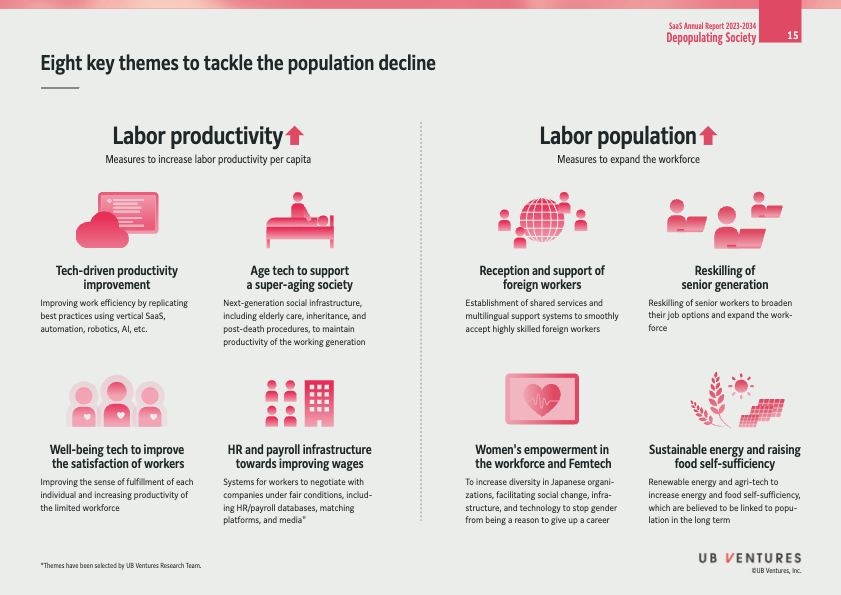
Overview
The report from UB Ventures outlines eight key themes aimed at addressing population decline through measures focused on labor productivity and expanding the labor population.
Labor Productivity Measures
-
Tech-driven Productivity Improvement
- Description: Enhancing work efficiency by adopting best practices in vertical Software as a Service (SaaS), automation, robotics, and artificial intelligence (AI).
- Insight: Leveraging technology can streamline operations and reduce manual labor, leading to increased output per worker.
-
Age Tech to Support a Super-aging Society
- Description: Developing next-generation social infrastructure to support elderly care and related services, ensuring productivity remains high among the working generation.
- Insight: Proactive care solutions can help maintain a healthy workforce, essential in societies with aging populations.
-
Well-being Tech to Improve the Satisfaction of Workers
- Description: Innovations aimed at enhancing individual fulfillment and productivity within a limited workforce.
- Insight: Addressing mental health and job satisfaction can lead to reduced turnover and increased overall productivity.
-
HR and Payroll Infrastructure Towards Improving Wages
- Description: Establishing systems for fair wage negotiations and enhancing transparency via HR/payroll databases and matching platforms.
- Insight: Fair compensation leads to higher employee morale and retention, crucial for maintaining a stable workforce.
Labor Population Measures
-
Reception and Support of Foreign Workers
- Description: Creating shared services and multilingual support systems to facilitate the integration of highly skilled foreign workers.
- Insight: Embracing talent from abroad can fill essential gaps in the workforce and promote diversity.
-
Reskilling of Senior Generation
- Description: Offering reskilling programs to enable older workers to expand their job options and remain active in the workforce.
- Insight: Utilizing experienced workers can provide mentorship and retain valuable knowledge within organizations.
-
Women's Empowerment in the Workforce and Femtech
- Description: Initiatives to diversify workplaces by addressing gender-related barriers through social change and technological advancements.
- Insight: Empowering women in the workforce not only promotes equality but can also help mitigate labor shortages.
-
Sustainable Energy and Raising Food Self-sufficiency
- Description: Advocating for renewable energy and agricultural technologies to improve self-sufficiency in energy and food production.
- Insight: Sustainability initiatives are likely tied to demographic stability, making them crucial for long-term population health.
Conclusion
These eight themes collectively provide a strategic approach to tackling population decline by improving labor productivity and expanding the workforce through innovative practices and inclusive measures. The integration of technology and focus on well-being and empowerment forms the backbone of these strategies.
Extended readings:
Issues and Solutions in Employment of Foreign Workers in Japan
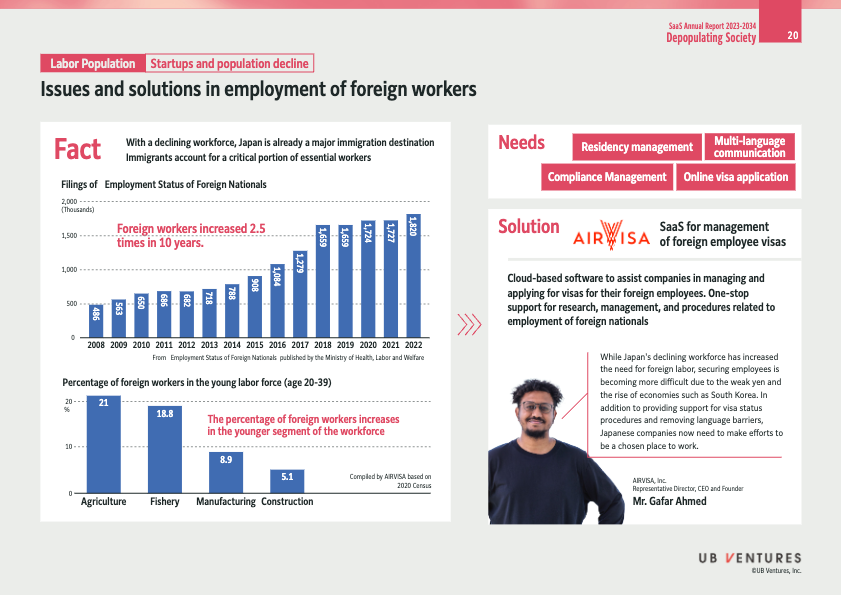
Fact
- Japan has a declining workforce and is becoming a significant immigration destination, with immigrants comprising a crucial part of the essential workforce.
- Foreign workers increased 2.5 times in the past decade.
Employment Filings Data (2008-2022)
| Year | Foreign Workers (Thousands) |
|---|---|
| 2008 | 486 |
| 2009 | 563 |
| 2010 | 650 |
| 2011 | 686 |
| 2012 | 682 |
| 2013 | 718 |
| 2014 | 788 |
| 2015 | 908 |
| 2016 | 1,084 |
| 2017 | 1,279 |
| 2018 | 1,659 |
| 2019 | 1,659 |
| 2020 | 1,724 |
| 2021 | 1,727 |
| 2022 | 1,820 |
Insight: The increase in foreign workers reflects a rising demand for labor in Japan, highlighting the country's struggles with a shrinking native workforce.
Percentage of Foreign Workers in Young Labor Force (Ages 20-39)
| Sector | Percentage of Foreign Workers (%) |
|---|---|
| Agriculture | 21 |
| Fishery | 18.8 |
| Manufacturing | 8.9 |
| Construction | 5.1 |
Insight: The data indicates that foreign workers are more prevalent in certain sectors, especially agriculture and fishery, which may signal areas where labor shortages are most acute.
Needs
- Residency Management: Efficiently managing the residency status of foreign workers.
- Multi-language Communication: Ensuring clear communication across language barriers.
- Compliance Management: Adhering to regulations governing the employment of foreign nationals.
- Online Visa Application: Streamlining the visa application process for foreign employees.
Insight: Addressing these needs is critical for companies striving to integrate foreign workers into their workforce effectively.
Solution: AIRVISA
- Description: Cloud-based software designed to assist companies in managing and applying for visas for foreign employees.
- Benefits: Offers one-stop support for research, management, and procedures related to the employment of foreign nationals.
Insight: Implementing advanced technologies like AIRVISA can help Japanese companies navigate the complexities of foreign labor laws and visa procedures effectively.
Contextual Challenges
- Despite the growing number of foreign workers, securing employees is becoming more challenging due to the weak yen and competition from countries like South Korea.
- Japanese companies need to improve their attractiveness as employers by offering support for visa processes and overcoming language barriers.
Insight: The interplay of economic factors and workforce dynamics necessitates innovative recruitment strategies to attract foreign talent.
Conclusion
Japan’s workforce challenges present both opportunities and challenges for foreign labor. By utilizing technology and addressing key needs, companies can successfully employ foreign workers and contribute to the economy's recovery amid demographic shifts.
Extended readings:
Good and Bad Mindsets for SaaS Expansion
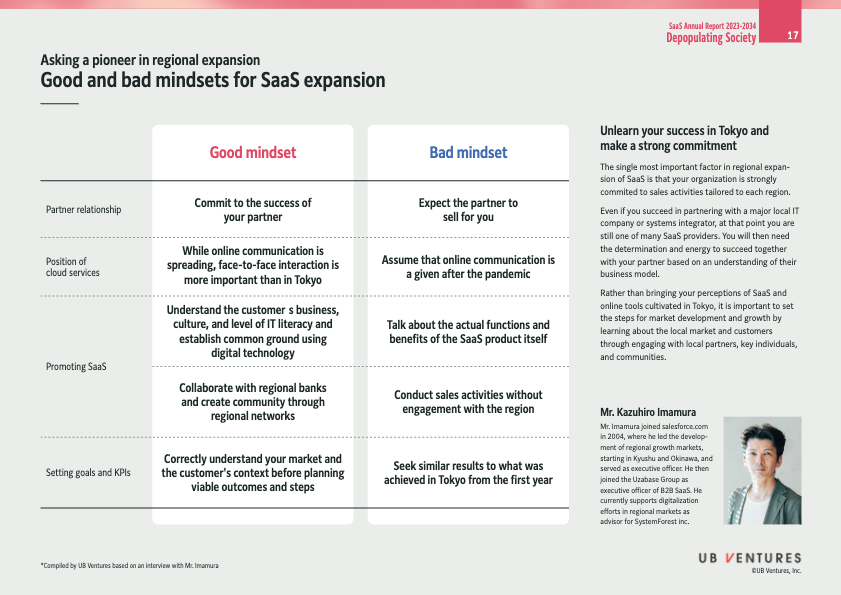
Overview
This document outlines the essential good and bad mindsets for Software as a Service (SaaS) expansion, particularly focusing on regional markets. Insights are derived from an interview with Mr. Kazuhiro Imamura, a pioneer in regional expansion.
Good Mindsets
| Aspect | Good Mindset | Insights |
|---|---|---|
| Partner Relationship | Commit to the success of your partner | Establishing a strong partnership is crucial for mutual growth. Prioritize their needs and success. |
| Position of Cloud Services | While online communication is spreading, face-to-face interaction is more important than in Tokyo | Personal interactions can build trust and deeper understanding of the partner's needs. |
| Promoting SaaS | Understand the customer’s business, culture, and level of IT literacy and establish common ground using digital technology | Tailor your approach based on the cultural context and technological capabilities of your clients. |
| Setting Goals and KPIs | Collaborate with regional banks and create community through regional networks | Leveraging local networks can enhance credibility and build a supportive ecosystem. |
| Correctly understand your market and the customer’s context before planning viable outcomes and steps | Researching market specifics ensures effective strategy and implementation. |
Bad Mindsets
| Aspect | Bad Mindset | Insights |
|---|---|---|
| Partner Relationship | Expect the partner to sell for you | This undermines the partner's role; success is a shared responsibility. |
| Position of Cloud Services | Assume that online communication is a given after the pandemic | Over-relying on digital communication can alienate partners who prefer direct engagement. |
| Promoting SaaS | Talk about the actual functions and benefits of the SaaS product itself | Focus should be on providing solutions to partners’ problems rather than on product features alone. |
| Setting Goals and KPIs | Conduct sales activities without engagement with the region | Lack of local engagement can lead to misunderstandings and ineffective strategies. |
| Seek similar results to what was achieved in Tokyo from the first year | Expecting identical outcomes across different regions is unrealistic and can set up for failure. |
Key Insights from Mr. Kazuhiro Imamura
- The principal factor in regional SaaS expansion is a strong commitment to tailored sales activities that match the local context.
- Even partnerships with established local IT companies require continuous effort and adaptability to thrive.
- Understanding local markets and engaging deeply with local communities is essential for successful expansion.
Background of Mr. Kazuhiro Imamura
- Joined Salesforce.com in 2004, leading regional market development, starting in Kyushu and Okinawa.
- Served as an executive officer before joining Uzabase Group to focus on B2B SaaS.
- Currently supports digitalization efforts in regional markets as an advisor for SystemForest, Inc.
Extended readings:
SaaS Annual Report 2023-2024
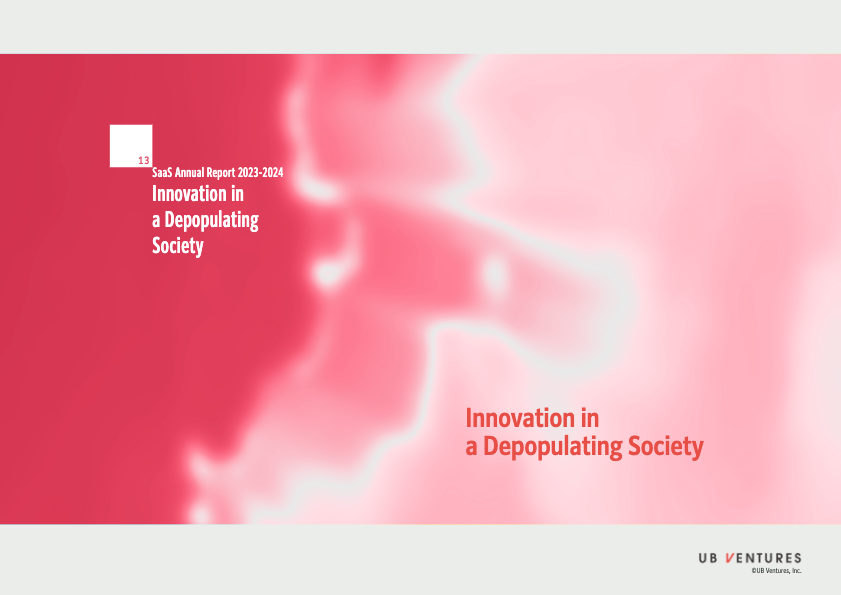
Innovation in a Depopulating Society
Key Points:
-
Title of Report: SaaS Annual Report 2023-2024
- This report focuses on the theme of innovation in the context of societal depopulation.
-
Main Theme: Innovation in a Depopulating Society
- Insight: Depopulation can lead to economic challenges, but it also opens avenues for innovation, particularly in technology and service delivery. Businesses may need to pivot their strategies to cater to a shrinking customer base.
Additional Information:
-
SaaS (Software as a Service) : A software distribution model in which applications are hosted in the cloud and accessed via the internet. This model allows for flexibility and scalability, which can be crucial in adapting to changing population dynamics.
-
Depopulation: Refers to the decline in population due to factors like lower birth rates, increased mortality rates, or migration. Understanding this trend is vital for businesses as they strategize for future growth or sustainability.
Contextual Note:
- The report suggests that while depopulation poses risks, it concurrently serves as a catalyst for innovative solutions in various sectors, including healthcare, education, and technology. Companies must be proactive in embracing these challenges as opportunities for growth.
Extended readings:
UB Ventures, Inc. Overview
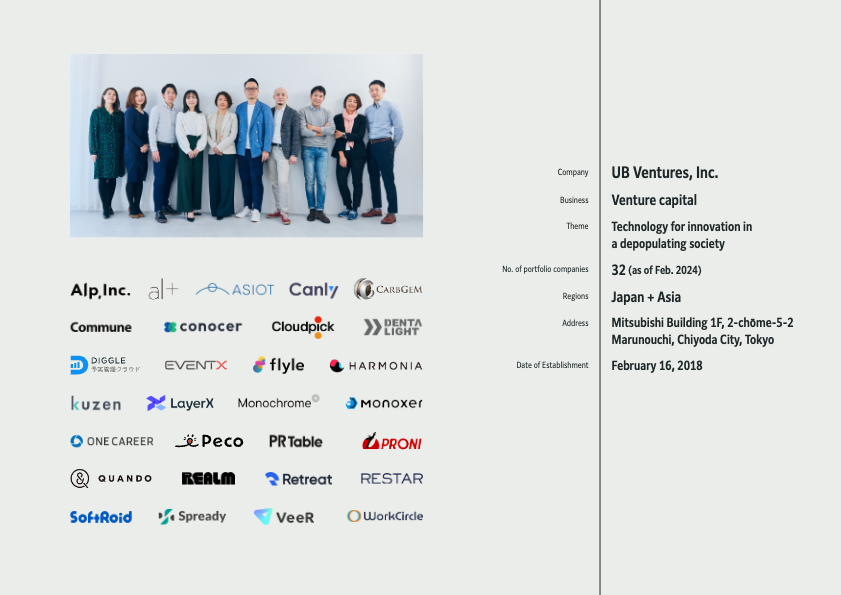
Company Information
- Name: UB Ventures, Inc.
- Business Sector: Venture Capital
- Theme: Focus on technology innovations addressing challenges in a depopulating society.
- Regions of Operation: Japan + Asia
- Date of Establishment: February 16, 2018
- Address: Mitsubishi Building 1F, 2-chome-5-2 Marunouchi, Chiyoda City, Tokyo
Portfolio Companies
As of February 2024, UB Ventures, Inc. has a total of 32 portfolio companies. These companies span various sectors reflecting the innovative focus of UB Ventures, particularly in response to societal trends.
Notable Portfolio Companies:
| Company Name |
|---|
| Alp, Inc. |
| alt |
| ASIOT |
| Canly |
| CarbGem |
| Commune |
| Conocer |
| Cloudpick |
| Denta Light |
| DIGGLE |
| EventX |
| Flyle |
| Harmonia |
| Kuzen |
| LayerX |
| Monochrome |
| Monoxer |
| ONE CAREER |
| Peco |
| PR Table |
| PRONI |
| Quando |
| Realm |
| Retreat |
| Restar |
| SoftRoid |
| SpreadY |
| Veer |
| WorkCircle |
Insights
- Focus on Depopulation: The theme of addressing depopulation indicates a strategic investment direction aimed at tackling demographic challenges, particularly relevant in countries like Japan.
- Diverse Portfolio: The range of companies shows a variety of innovative technologies, suggesting that UB Ventures is looking for disruptive startups that can create significant societal impact.
- Expansion Potential: With a focus on both Japan and Asia, there's potential for cross-border collaborations and investments, enhancing their reach and influence.
Conclusion
UB Ventures, Inc. positions itself as a forward-thinking venture capital firm, dedicated to harnessing technology to solve modern societal issues. The diverse portfolio illustrates a strategic commitment to innovation in critical areas.
Extended readings:
Notes on Japan's Social Infrastructure and Depopulation Issues
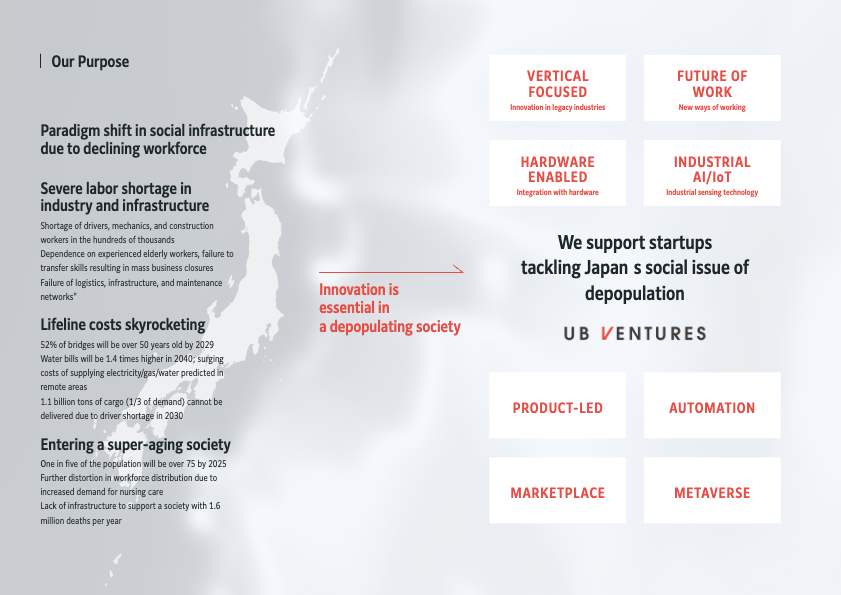
Paradigm Shift Due to Declining Workforce
- Japan is experiencing a significant transformation in its social infrastructure primarily due to a declining workforce.
- This shift necessitates innovative solutions to address emerging challenges.
Severe Labor Shortages
- Affected Industries:
- Drivers
- Mechanics
- Construction workers
- Impact:
- Shortages in thousands, leading to dependency on experienced elderly workers.
- Failure in transferring skills results in mass business closures.
- Breakdown of logistics, infrastructure, and maintenance networks.
Lifeline Costs Skyrocketing
- Bridges:
- 52% of bridges are projected to be over 50 years old by 2029.
- Water Costs:
- Water bills anticipated to be 1.4 times higher by 2040.
- Increasing costs of providing utilities (electricity, gas, water) in remote areas.
- Cargo Shortages:
- 1.1 billion tons of cargo (approximately one-third of total demand) cannot be delivered due to projected driver shortages by 2030.
Entering a Super-aging Society
- Demographics:
- One in five individuals will be over the age of 75 by 2025.
- Implications:
- Workforce distribution increasingly strained due to heightened demand for nursing care.
- Insufficient infrastructure to support a society with an expected 1.6 million deaths annually.
Innovation as a Solution
- Core Message:
- "Innovation is essential in a depopulating society."
- Focus Areas for Startups:
- Vertical Focused: Innovation within legacy industries to modernize practices.
- Future of Work: Development of new working models to adapt to changing demands.
- Hardware Enabled: Integration of advanced hardware solutions to improve efficiency.
- Industrial AI/IoT: Utilization of industrial sensing technology to enhance operational capabilities.
- Product-Led: Strategies centered around product innovation to tackle emerging needs.
- Automation: Enhancing processes through automation to mitigate labor shortages.
- Marketplace and Metaverse: Exploring digital solutions to connect supply and demand in innovative ways.
These notes underscore the critical situation Japan faces due to its declining workforce, highlighting both the challenges and the innovative avenues that can be pursued to mitigate the effects of depopulation.
Extended readings:
SaaS is Now a Mature Industry. Will It Serve as Infrastructure to Support a Depopulating Society?
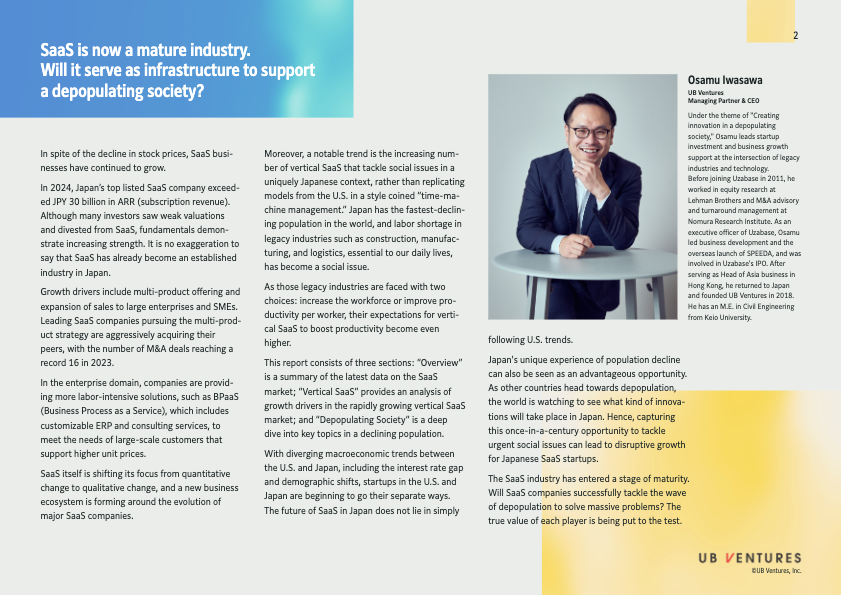
Overview of the SaaS Market in Japan
-
Growth Despite Stock Price Declines:
- In 2024, Japan's top SaaS company exceeded JPY 30 billion in Annual Recurring Revenue (ARR).
- Strong fundamentals indicate SaaS has become a significant industry in Japan despite investor concerns.
-
M&A Activity:
- The number of Mergers and Acquisitions (M&A) reached a record of 16 in 2023, reflecting a trend toward consolidation among leading SaaS companies.
-
Market Drivers for Growth:
- Multi-product offerings and expanding sales to large enterprises and SMEs (Small and Medium-sized Enterprises) drive growth.
- Traditional sectors adopting SaaS for efficiency.
Vertical SaaS and Social Issues
-
Emerging Trend of Vertical SaaS:
- There is an increasing number of SaaS solutions targeting social issues specific to Japan, diverging from U.S. models.
- This trend is described as "time-machine management," focusing on addressing Japan's unique challenges, such as labor shortages in legacy industries (construction, manufacturing, logistics).
-
Labor Shortages:
- Japan has the fastest-declining population globally, leading to a pronounced labor shortage.
- Legacy industries are compelled to either increase workforce numbers or enhance productivity per worker, raising expectations for vertical SaaS to deliver solutions.
Report Structure and Focus Areas
-
Sections of the Report:
- Overview: Latest data on the SaaS market in Japan.
- Vertical SaaS: Analysis of growth drivers within this rapidly growing sector.
- Depopulating Society: In-depth examination of challenges and opportunities presented by a declining population.
-
Macroeconomic Trends:
- Japan's economic conditions differ from those in the U.S., including interest rate disparities and demographic shifts, prompting a unique path for SaaS development.
Opportunities and Challenges
-
Japan as a Case Study:
- Japan's experience with depopulation presents an opportunity to develop innovative solutions that could be models for other countries facing similar challenges.
-
SaaS Industry Maturity:
- The SaaS sector is reaching a stage of maturity, prompting questions about its ability to address significant social issues arising from population decline.
-
Value of Each Player:
- The potential of SaaS companies will be tested as they tackle pressing societal problems and demonstrate their true value in the evolving landscape.
Key Insights from Osamu Iwasawa
-
Role of Leadership:
- Osamu Iwasawa emphasizes the creation of innovation to address the challenges of a depopulating society, drawing from experience in investment and technology.
-
SaaS Evolution:
- There is a shift from purely quantitative growth metrics to qualitative changes within the SaaS ecosystem, indicating a move toward sustainable and impactful solutions.
By focusing on these key themes and insights, stakeholders in the SaaS industry can better navigate the complexities of a mature market while actively addressing societal challenges.
Extended readings:
Top Vertical SaaS Startups in Japan by Valuation
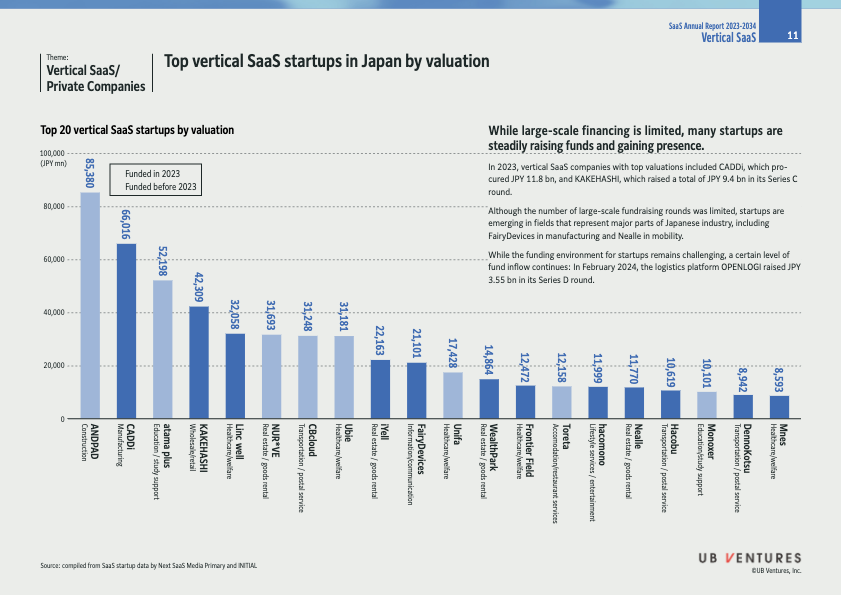
Overview
The chart presents the top 20 vertical Software as a Service (SaaS) startups in Japan based on their valuations. It highlights funding received in 2023 versus before 2023 and reveals trends in various sectors.
Key Insights
- Vertical SaaS: These are specialized SaaS solutions tailored for specific industries. The growth of vertical SaaS indicates how technology is being integrated into traditional sectors to improve efficiency and services.
- Funding Landscape: Despite challenges in large-scale financing, startups continue to attract investment, particularly in key industries like manufacturing and healthcare.
Top 20 Vertical SaaS Startups by Valuation
| Rank | Company | Valuation (JPY mn) | Sector | Funded Year |
|---|---|---|---|---|
| 1 | ANDPAD | 85,380 | Construction | 2023 |
| 2 | CADDi | 66,016 | Manufacturing | 2023 |
| 3 | atama plus | 52,198 | Education / Study Support | 2023 |
| 4 | KAKEHASHI | 42,309 | Wholesale/Retail | Before 2023 |
| 5 | Linc well | 32,058 | Healthcare/Welfare | 2023 |
| 6 | NUR*VE | 31,693 | Real Estate / Goods Rental | 2023 |
| 7 | CBcloud | 31,248 | Transportation / Postal Service | Before 2023 |
| 8 | Ubie | 31,181 | Healthcare/Welfare | Before 2023 |
| 9 | iYell | 22,163 | Real Estate / Goods Rental | Before 2023 |
| 10 | FairyDevices | 21,101 | Information/Communication | Before 2023 |
| 11 | Unifa | 17,428 | Healthcare/Welfare | Before 2023 |
| 12 | WealthPark | 14,864 | Real Estate / Goods Rental | Before 2023 |
| 13 | Frontier Field | 12,472 | Healthcare/Welfare | Before 2023 |
| 14 | Toreta | 12,158 | Accommodation/Restaurant Services | Before 2023 |
| 15 | hacomono | 11,999 | Lifestyle Services / Entertainment | Before 2023 |
| 16 | Nealle | 11,770 | Real Estate / Goods Rental | Before 2023 |
| 17 | Hacobu | 10,619 | Transportation / Postal Service | Before 2023 |
| 18 | Monoxer | 10,101 | Education / Study Support | Before 2023 |
| 19 | DennoKotsu | 8,942 | Transportation / Postal Service | Before 2023 |
| 20 | Mnes | 8,593 | Healthcare/Welfare | Before 2023 |
Additional Information
- In 2023, CADDi and KAKEHASHI led in valuations, with significant fund inflows marking their growth.
- Key sectors such as manufacturing (represented by FairyDevices) and mobility (represented by Nealle) are emerging as vital areas for innovation and investment.
- The funding climate remains challenging, but there are still positive signs of investment, as seen with OPENLOGI, which secured JPY 3.55 billion in February 2024 for its Series D round.
Understanding these trends can provide insights into the future of vertical SaaS in Japan and highlight opportunities for growth in various sectors.
Extended readings:
SaaS Annual Report 2023-2024
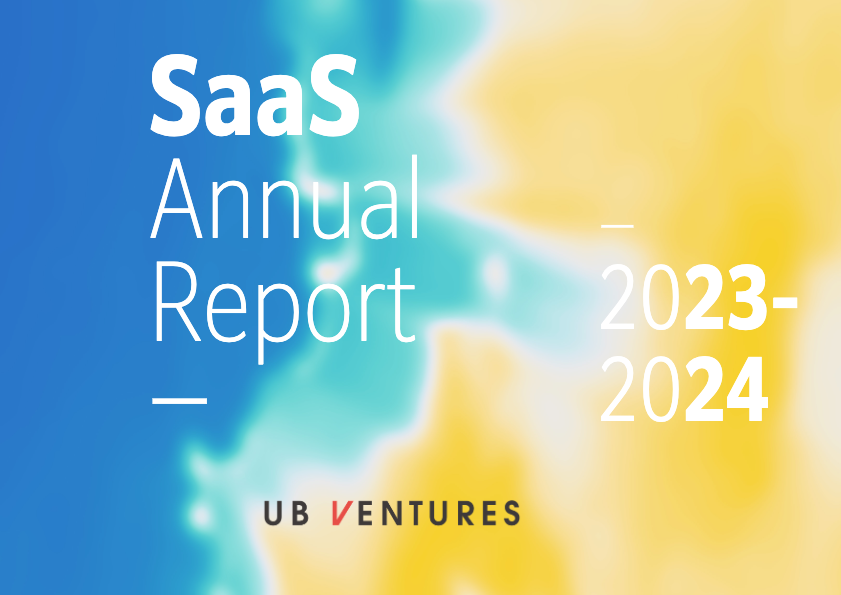
Overview
- The document pertains to the SaaS (Software as a Service) Annual Report for the fiscal year 2023-2024.
- SaaS is a cloud-based service where instead of downloading software on your desktop PC or business network to run and update, you instead access an application via your web browser.
Key Components
-
SaaS Model:
- Providers host applications and make them available to customers over the Internet.
- Common benefits include reduced costs, scalability, automatic updates, and accessibility from anywhere with an Internet connection.
-
UB Ventures:
- The report is published by UB Ventures, suggesting involvement in technology investment or consulting within the SaaS sector.
Insights and Ideas
-
Market Trends:
- Increasing migration of businesses to cloud-based solutions due to flexibility and cost-effectiveness.
- Enhanced focus on security and compliance standards as regulations evolve.
-
Investment Insights:
- Investors should be aware of key players and trends within the SaaS market, potentially leading to identifying promising investment opportunities.
-
Future Projections:
- The year might witness innovations in AI-driven SaaS applications that enhance user experience and operational efficiency.
Conclusion
- This report serves as an essential resource for stakeholders interested in the SaaS landscape, helping them understand market dynamics, investment opportunities, and technological advancements expected in 2023-2024.
Extended readings:
UB Ventures SaaS Annual Report 2023-2024
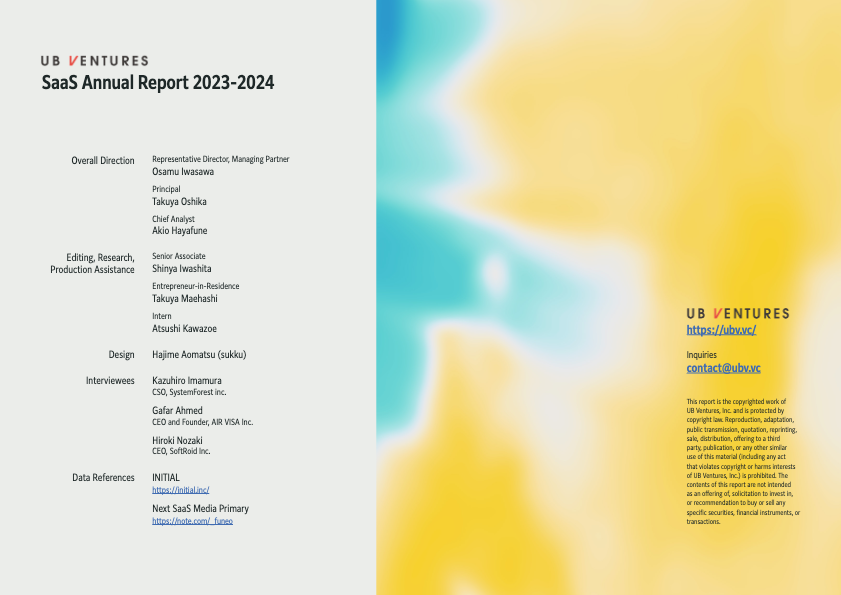
Overall Direction
- Representative Director, Managing Partner: Osamu Iwasawa
- The key figure responsible for guiding the strategic direction of UB Ventures.
- Principal: Takuya Oshika
- Oversees specific principal functions, likely focusing on investment strategies.
- Chief Analyst: Akio Hayafune
- Responsible for analyzing market trends and SaaS performance.
Editing, Research, Production Assistance
- Senior Associate: Shinya Iwashita
- Involved in high-level editing and research to ensure quality.
- Entrepreneur-in-Residence: Takuya Maehashi
- A role typically filled by an experienced entrepreneur who provides insights and guidance.
- Intern: Atsushi Kawazoe
- Supports with various tasks, gaining experience in the field.
Design
- Designer: Hajime Aomatsu (sukku)
- Responsible for the visual aspects of the report, ensuring it is professionally presented.
Interviewees
- Kazuhiro Imamura, CSO, SystemForest Inc.
- Provides insights regarding cybersecurity or system management within SaaS.
- Gafar Ahmed, CEO and Founder, AIR VISA Inc.
- Focuses on the intersection of travel technologies and payment solutions in SaaS.
- Hiroki Nozaki, CEO, SoftRoid Inc.
- Represents advancements in software solutions and automation.
Data References
- INITIAL: Initial
- Likely a data provider or analytics firm referenced in the report.
- Next SaaS Media Primary: Next SaaS Media
- A media platform that may offer insights and reports on the SaaS industry.
Inquiries
- Contact: contact@ubv.vc
- Website: UB Ventures
Copyright Information
- This report is the copyrighted work of UB Ventures, Inc. and is protected by copyright law. Unauthorized reproduction, adaptation, or distribution is prohibited. The contents of this report are not investment recommendations.
Insights
- The report appears to offer significant insights into the SaaS industry, with a focus on expert interviews, highlighting the importance of informed perspectives in strategic decision-making.
- The diverse roles suggest a comprehensive approach toward both analytical research and hands-on entrepreneurial experience, which are critical in navigating the fast-paced SaaS landscape.
Extended readings: